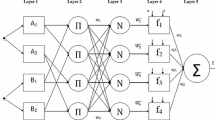Abstract
In this paper, we address the problem of planning the universal mobile telecommunication system base stations location for uplink direction. The objective is to maximize the total traffic covered and minimize the total installation cost based on data involving fuzziness. To define the cost, researchers used the current period market prices as constants. However prices may change over time. Our aim here is to deal with the imprecise and uncertain information of prices. For this we introduce a model of problem where each cost is a fuzzy variable, and then we present a decision-making model based on possibility theory. To solve the problem we propose a search algorithm based on the hybridization of genetic algorithm and local search method. To validate the proposed method some numerical examples are given.










Similar content being viewed by others
References
Amaldi E, Capone A, Malucelli F (2003a) Planning UMTS base station location: optimization models with power control and algorithms. IEEE Trans Wirel Commun 2(5):939–952
Amaldi E, Capone A, Malucelli F, Signori F (2003b) Radio planning and optimization of W-CDMA systems. Pers Wirel Commun 2775:437–447
Amaldi E, Capone A, Malucelli F (2008) Radio planning and coverage optimization of 3G cellular networks. Wirel Netw. 14:435–447
Berruto E, Gudmundson M, Menolascino R, Mohr W, Pizarroso M (1998) Research activities on UMTS radio interface, network architectures, and planning. IEEE Commun Mag 36:82–95
Bontoux B (2008) Techniques hybrides de recherche exacte et approche: application des problmes de transport. Ph.D. thesis, University of Avignon and the Vaucluse
Coello CAC (2010) List of references on evolutionary multiobjective optimization. http://www.lania.mx/ccoello/EMOO/EMOObib.html
Dreo J, Petrowski A, Siarry P, Taillard E (2003) Metaheuristiques pour l’optimisation difficile. Eyrolles, Paris
Dubois D, Prade H (1980) Fuzzy sets and systems. Academic Press, New York
Gabli M, Jaara EM, Mermri EB (2013) Planning UMTS base station location using genetic algorithm with a dynamic trade-off parameter. In: Lecture note of computer science, vol 7853. Springer, Heidelberg, pp 120–134
Hashemi SM, Moradi A, Rezapour M (2008) An ACO algorithm to design UMTS access network using divided and conquer technique. Eng Appl Artif Intell 21:931–940
Hata M (1980) Empirical formula for propagation loss in land mobile radio services. IEEE Trans Veh Technol VT–29:317–325
Juttner A, Orban A, Fiala Z (2005) Two new algorithms for UMTS access network topology design. Eur J Oper Res 164:456–474
Katagiri H, Mermri EB, Sakawa M, Kato K, Nishizaki I (2005) A possibilistic and stockastic programming approach to fuzzy random MST problem. IEICE Trans Inf Syst E88–D 8:1912–1919
Konak A, Coit DW, Smith AE (2006) Multi-objective optimization using genetic algorithms: a tutorial. Reliab Eng Syst Saf 91:992–1007
Kumar R, Parida PP, Gupta M (2002) Topological design of communication networks using multiobjective genetic optimization. In: Proceedings of the 2002 world congress on computational intelligence-WCCI’02, 12–17 May, 2002. Honolulu, HI, USA. IEEE
Mermri EB, Katagiri H, Sakawa M, Ishii H (2009) A variance minimization model for fuzzy randon minimum spanning tree problems. Sci Math Jpn Online e–2009:539–550
Meunier H (2002) Algorithmes evolutionnaires paralleles pour l’optimisation multi objectif de reseaux de telecommunications mobiles. Ph.D. thesis, University of Sciences and Technologies, Lille
Mundt T (2004) How much is a byte? A survey of costs for mobile data transmission. In: 04 proceedings of the winter international synposium on Information and communication technologies (WISICT)
Naghshineh M, Katzela I (1996) Channel assignment schemes for cellular mobile telecommunication systems: a comprehensive survey. IEEE Pers Commun 3:10–31
Peng YJ, Soong BH, Wang LP (2004) Broadcast scheduling in packet radio networks using mixed tabu–greedy algorithm. Electron Lett 40(6):375–376
Sakawa M (1993) Fuzzy sets and interactive multiobjective optimization, vol 1. Plenum Press, New York
Salcedo-Sanz S, Santiago-Mozos R, Bousono-Calzon C (2004) A hybrid Hopfield network-simulated annealing approach for frequency assignment in satellite communications systems. IEEE Trans Syst Man Cybern Part B 34:1108–1116
St-Hilaire M, Chamberland S, Pierre S (2006) Uplink UMTS network design-an integrated approach. Comput Netw 50:2747–2761
Thiel SU, Giuliani P, Ibbetson LJ, Lister D (2002) An automated UMTS site selection tool. In: 3rd international conference on 3G mobile communication technologies, pp 69–73
Wang LP, Li S, Tian F, Fu X (2004) A noisy chaotic neural network for solving combinatorial optimization problems: stochastic chaotic simulated annealing. IEEE Trans Syst Man Cybern Part B-Cybern 34(5):2119–2125
Wang LP, Shi H (2006) A gradual noisy chaotic neural network for solving the broadcast scheduling problem in packet radio networks. IEEE Trans Neural Netw 17(4):989–1000
Wang LP, Liu W, Shi H (2008) Noisy chaotic neural networks with variable thresholds for the frequency assignment problem in satellite communications. IEEE Trans Syst Man Cybern Part C-Rev Appl 38(2):209–217
Wang LP, Liu W, Shi H (2009) Delay constrained multicast routing using the noisy chaotic neural networks. IEEE Trans Comput 58(1):82–89
Wu Y, Pierre S (2003) Optimization of access network design in 3G networks. Can Conf Electr Comput Eng 2:781–784
Yang Y (2003) UMTS investment study. In: Technical report T-109.551, Telecommunication business II, Helsinki University, Helsinki
Zadeh LA (1978) Fuzzy sets as a basis for a theory of possibility. Fuzzy Sets Syst 1:3–28
Zadeh LA (2008) Is there a need for fuzzy logic? Inf Sci 178:2751–2779
Zdunek R, Ignor T (2010) UMTS base station location planning with invasive weed optimization. Lect Notes Comput Sci 6114:698–705
Author information
Authors and Affiliations
Corresponding author
Additional information
Communicated by V. Loia.
Rights and permissions
About this article
Cite this article
Gabli, M., Jaara, E.M. & Mermri, E.B. A possibilistic approach to UMTS base-station location problem. Soft Comput 20, 2565–2575 (2016). https://doi.org/10.1007/s00500-015-1658-9
Published:
Issue Date:
DOI: https://doi.org/10.1007/s00500-015-1658-9




